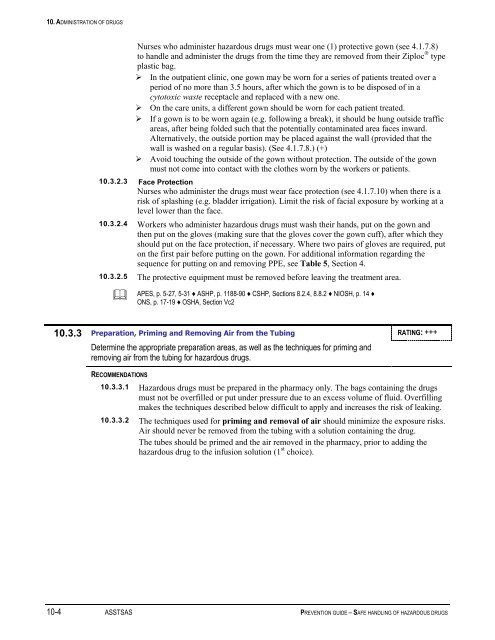Prevention Guide - Safe Handling of Hazardous Drugs - Irsst
Prevention Guide - Safe Handling of Hazardous Drugs - Irsst
Prevention Guide - Safe Handling of Hazardous Drugs - Irsst
You also want an ePaper? Increase the reach of your titles
YUMPU automatically turns print PDFs into web optimized ePapers that Google loves.
10. ADMINISTRATION OF DRUGS<br />
Nurses who administer hazardous drugs must wear one (1) protective gown (see 4.1.7.8)<br />
to handle and administer the drugs from the time they are removed from their Ziploc ® type<br />
plastic bag.<br />
‣ In the outpatient clinic, one gown may be worn for a series <strong>of</strong> patients treated over a<br />
period <strong>of</strong> no more than 3.5 hours, after which the gown is to be disposed <strong>of</strong> in a<br />
cytotoxic waste receptacle and replaced with a new one.<br />
‣ On the care units, a different gown should be worn for each patient treated.<br />
‣ If a gown is to be worn again (e.g. following a break), it should be hung outside traffic<br />
areas, after being folded such that the potentially contaminated area faces inward.<br />
Alternatively, the outside portion may be placed against the wall (provided that the<br />
wall is washed on a regular basis). (See 4.1.7.8.) (+)<br />
‣ Avoid touching the outside <strong>of</strong> the gown without protection. The outside <strong>of</strong> the gown<br />
must not come into contact with the clothes worn by the workers or patients.<br />
10.3.2.3 Face Protection<br />
Nurses who administer the drugs must wear face protection (see 4.1.7.10) when there is a<br />
risk <strong>of</strong> splashing (e.g. bladder irrigation). Limit the risk <strong>of</strong> facial exposure by working at a<br />
level lower than the face.<br />
10.3.2.4 Workers who administer hazardous drugs must wash their hands, put on the gown and<br />
then put on the gloves (making sure that the gloves cover the gown cuff), after which they<br />
should put on the face protection, if necessary. Where two pairs <strong>of</strong> gloves are required, put<br />
on the first pair before putting on the gown. For additional information regarding the<br />
sequence for putting on and removing PPE, see Table 5, Section 4.<br />
10.3.2.5 The protective equipment must be removed before leaving the treatment area.<br />
<br />
APES, p. 5-27, 5-31 ♦ ASHP, p. 1188-90 ♦ CSHP, Sections 8.2.4, 8.8.2 ♦ NIOSH, p. 14 ♦<br />
ONS, p. 17-19 ♦ OSHA, Section Vc2<br />
10.3.3 Preparation, Priming and Removing Air from the Tubing RATING: +++<br />
Determine the appropriate preparation areas, as well as the techniques for priming and<br />
removing air from the tubing for hazardous drugs.<br />
RECOMMENDATIONS<br />
10.3.3.1 <strong>Hazardous</strong> drugs must be prepared in the pharmacy only. The bags containing the drugs<br />
must not be overfilled or put under pressure due to an excess volume <strong>of</strong> fluid. Overfilling<br />
makes the techniques described below difficult to apply and increases the risk <strong>of</strong> leaking.<br />
10.3.3.2 The techniques used for priming and removal <strong>of</strong> air should minimize the exposure risks.<br />
Air should never be removed from the tubing with a solution containing the drug.<br />
The tubes should be primed and the air removed in the pharmacy, prior to adding the<br />
hazardous drug to the infusion solution (1 st choice).<br />
10-4 ASSTSAS PREVENTION GUIDE – SAFE HANDLING OF HAZARDOUS DRUGS

















